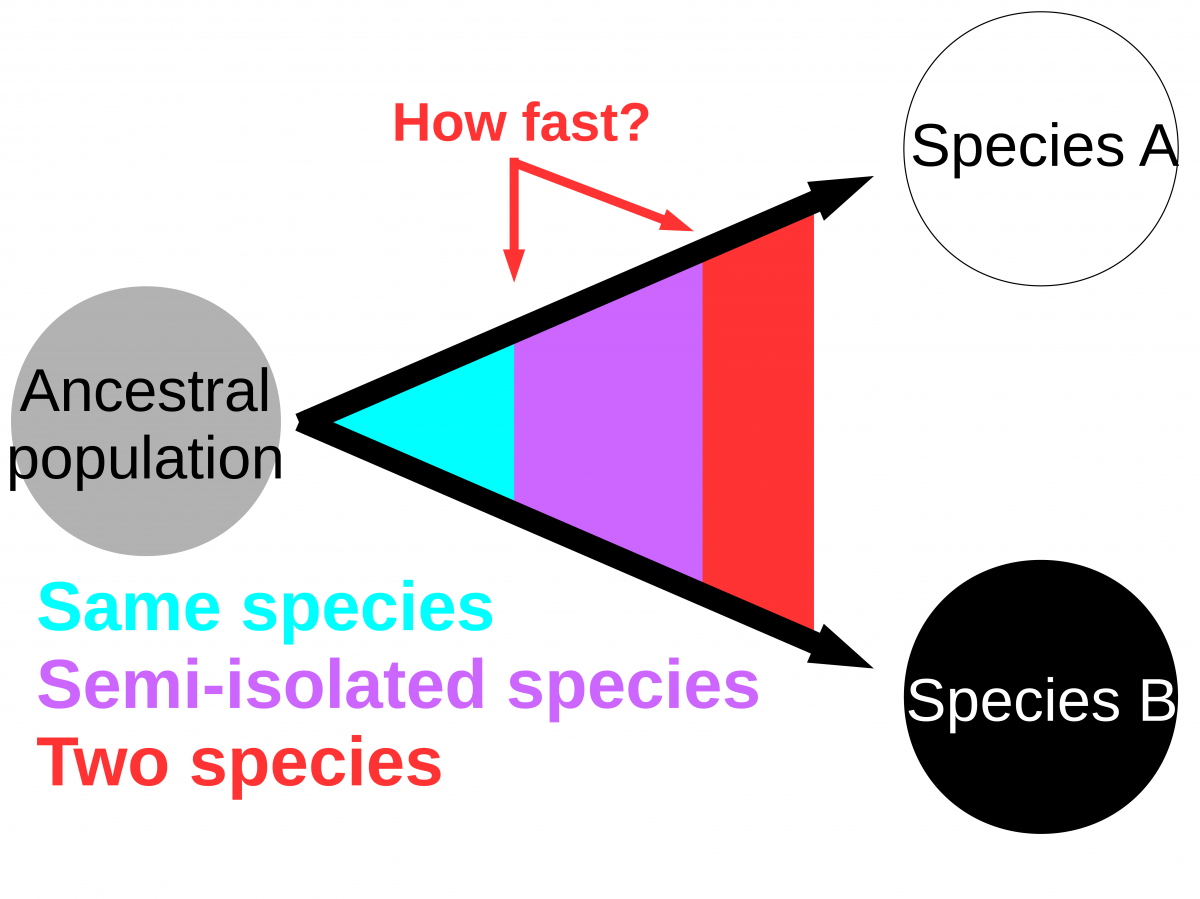Spéciation
- Recherche
- Membres
Objectifs
La diversité, mesurée par le nombre d'espèces existantes, est le résultat d'une dynamique qui combine les processus générant de nouvelles espèces (événements de spéciation) et d'autres qui réduisent le nombre de taxons (extinctions). Les taux d'extinction contemporains, mesurés par la réduction du nombre d'espèces ou par la réduction continue de la taille des populations se révèle extrêmement importants, tant pour les plantes que pour les animaux, sans doute en conséquence des changements mondiaux en cours. Bien que la diversité des facteurs responsables des extinctions commence à être bien compris, nos connaissances sur les mécanismes de la spéciation sont relativement moins solides. Pour avoir un aperçu détaillé du processus de spéciation, il nous faudrait comprendre les différents facteurs provoquant l'isolement reproducteur, c'est-à-dire l'évolution des barrières entre espèces. Ces dernières ont des effets négatifs sur la viabilité ou la fertilité des hybrides, réduisant la possibilité d'hybridation entre des lignées ayant divergées.
Notre objectif est d'étudier ce processus à différents niveaux. Tout d'abord au niveau génomique, en identifiant certains facteurs expliquant la densité locale dans les gènes de spéciation. Certains grands patrons chromosomiques sont déjà bien identifiés empiriquement : par exemple, les chromosomes sexuels concentrent fortement les gènes agissant comme des barrières entre espèces. Deuxièmement, au niveau géographique car l'isolement des populations tendra à faciliter la fixation de ces barrières d'espèces, alors que la migration ralentira ce processus. Troisièmement, au niveau de l'environnement, pour comprendre comment les processus adaptatifs vont conduire à l'accumulation des mutations avec des effets différents sur la fitness des hybride.
Les principaux objectifs du groupe spéciation sont donc d'explorer les contributions de la génomique, de la géographie et des facteurs environnementaux sur l'émergence de nouvelles espèces. Pour répondre à ces questions sur les différentes sur les échelles de temps de l'évolution, le groupe rassemble des chercheurs avec des approches paléontologique, génétique, génomique, bioinformatique, phylogénétique et de morphologie quantitative.

Ongoing projects.
Use of allelic and phylogenetic diversity at the self-incompatibility locus of Brassicaceae as a marker of bottlenecks associated with speciation. C. Poux, C Roux and X. Vekemans (PI).
In this project we compare allelic diversity and phylogenetic relationships among alleles at the self-incompatibility locus within and between related species in order to identify possible bottlenecks associated with speciation events. This approach, using the phenomenon of increased conservation of ancestral polymorphism under the effect of strong balancing selection at the self-incompatibility locus (cf. Castric et al. Plos Genetics, 2008) is complementary and will be compared to the historical demographic inference approach based on neutral polymorphism at the genome level.
Development of demographic inference methods taking into account selection. C. Mazoyer, X. Vekemans and C. Roux (PI)
We are developing a web application to produce demographic inferences from sequencing data in order to 1) study changes in population size over time; 2) test different introgression patterns; 3) detect barriers to gene flow, by taking into account genomic variations in effective population size due to genetic interference, as well as genomic variations in introgression rates caused by semi-permeable barriers.
Linking microevolutionary and macroevolutionary processes of diversification in evolutionary radiations of freshwater mollusks from the East African Rift. C. Blassiau, C. Calarnou, M. Genete, C. Gode, C. Ortiz, C. Roux, X. Vekemans and B. Van Bocxlaer (PI)
Work in evolution, ecology and paleontology has resulted in a great body of knowledge on processes contributing to reproductive isolation between extant populations and on how organismal diversity has waxed and waned through time. How mechanisms that cause differentiation among populations ultimately contribute to macroevolution remains currently unanswered, however. We address this and related questions with phylogenetic/genomic and population genetic/genomic approaches at various spatial and taxonomic scales of organization in freshwater mollusks form the East African Rift. Much of our focus is on small evolutionary radiations, which are the building blocks of African freshwater mollusk diversity. Our studies often include examinations of morphological disparity, including of the fossil record, and laboratory experiments designed to test hypotheses constructed from molecular and morphological studies, such as whether certain traits are inherited and adaptive. Finally, we are also interested in community assembly, the environmental context of parasite transmission by freshwater mollusks and conservation biology.
Speciation and mating systems in Silene. F. Carpentier, S. Gallina, C. Godé, Z. Postel, C. Poux, C. Roux, E. Schmitt, X. Vekemans and P. Touzet (PI)
We are studying the interplay of mating systems and the emergence of reproductive barriers in two mating systems:
- gynodioecy, i.e. the co-occurrence in populations of females and hermaphrodites, that can favor the maintenance of old and divergent cytoplasms through balancing selection. We hypothesize that such system might allow the accumulation of cytonuclear incompatibilities among geographically isolated lineages. We test this hypothesis on Silene nutans, a gynodioecious species that revealed to be a species complex, with at least 4 different genetic lineages. Inter-lineage hybrids exhibit strong postzygotic reproductive isolation mostly due to cytonuclear genetic incompatibilities. This project (Zoé Postel’s PhD thesis) aims to identify co-evolved cytonuclear gene pairs that have been disrupted in these hybrids, and propose an evo-demographic scenario on this speciation process through ABC approaches. This project relies on a long and strong collaboration with Fabienne Van Rossum from Meise Botanic garden, Belgium.
- dioecy, i.e. the co-occurrence in populations of females and males. When dioecy is determined by sex chromosomes, we hypothesize that sex chromosomes might accumulate genetic incompatibilities, that leads to the Haldane rule: the heterogametic sex is more affected in interspecies hybrids. We want to test this hypothesis on the dioecious species in the Silene section Otites.
Collaborators on Silene nutans: Jean-Stéphane Varré (CRIStAL, Univ. Lille), Fabienne Van Rossum (Meise Botanic Garden, Belgium)
Collaborators on the section Otites: Gabriel Marais (LBBE, Univ. Lyon), Bohous Janousek (Institute of Biophysics, ASCR, Brno, Czech Republic)

